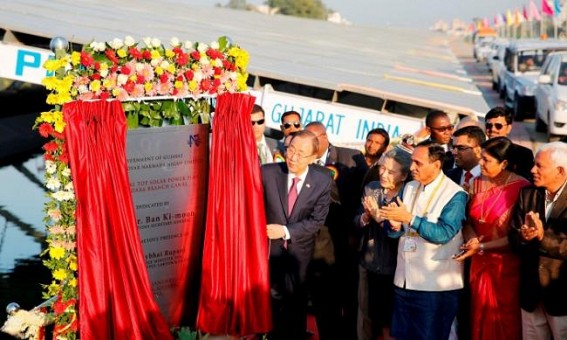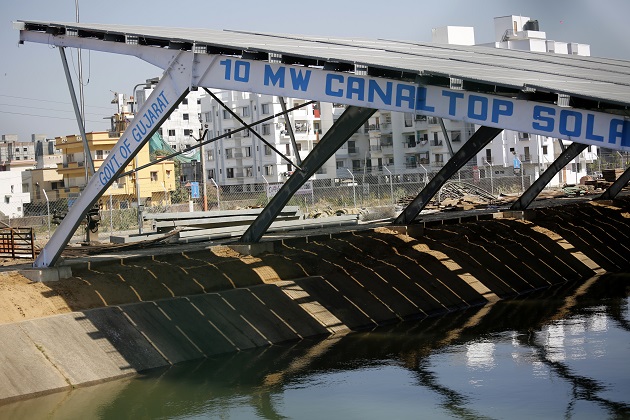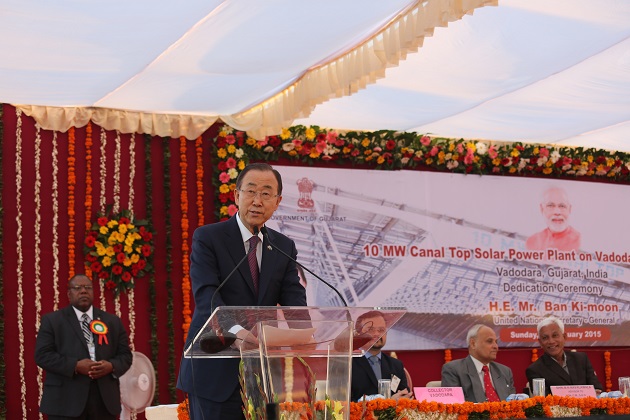Nava Thakuria Senior Journalist

PHOTO : UN Secretary-General Ban Ki-moon inaugurating canal top 10MW solar power plant. Pic by Nava Thakuria
It was a sunny afternoon, when the UN Secretary-General Ban Ki-moon inaugurated a canal top solar power plant at Vadodara (earlier known as Baroda) of Gujarat in western India, where the UN chief highly commended the vision and leadership of Indian Prime Minister Narendra Modi, who initiated the impressive project during his tenure as the Gujarat chief minister.
Addressing a distinguished gathering soon after unveiling the plaque of 10 megawatt (MW) solar power project on 11 January 2015, the UN Secretary-General stated, “Looking out at the canal top solar power plant, I saw more than glittering panels – I saw the future of India and the future of our world. I saw India’s bright creativity, ingenuity and cutting-edge technology.”
Appreciating the leadership on sustainable development of Prime Minister Modi and also the present government of Gujarat for taking care of and carrying over the very impressive project, Ban Ki-moon, commented that the mission ‘demonstrates that one solution can have multiple benefits’.
“Solar power protects the environment. It creates development. It helps us conserve land. And it promotes health and prosperity. More solar power means less pollution. And that will lead to cleaner air and healthier lives,” said the UN Secretary-General.
He also added that the sun has a special place in the Indian imagination. The United Nations even recognizes the Indian Sun Temple Konârak as a UNESCO World Heritage Site. People of all faiths and all countries have for millennia appreciated the immense value and powerof our sun. But we have only just begun to harness the sun’s energy for the good of our planet and its people, he added.

The solar power plant, atop a 22 meter width canal of running water, covers around 4 kilometer (KM) in length, where 33,816 solar panels have been installed over a mounting structure. The Rupees 1000 million project, set up by Sardar Sarovar Narmada Nigam Limited (SSNNL), is fully financed by the State government in Ahmadabad.
The showcase project of the relatively rich Indian State is executed by the Megha Engineering and Infrastructure Limited (MEIL), which will also maintain it for the next 25 years. The Hyderabad based MEIL had earlier constructed a 50 MW solar plant in Maharashtra and a 20 MW plant in Andhra Pradesh.
The plant is expected to produce over 16 million units of power in the first year and the entre output will be consumed by the SSNNL,informed the company’s chief engineer U C Jain. He also added that
India had an advantage of going for solar mission as the country gets 70% more solar radiation than any European country. Jain also claimed that a solar power plant can be erected very fast compare to other green projects.
Gujarat chief minister Anandi B Patel, while talking to the local media prior to the inauguration of the Vadodara canal top project,disclosed that the SSNNL was purchasing power from a different
company (Gujarat Urja Vin Nigam Limited) at the cost of rupees 6.48 per unit, where the prices were soaring annually, but the new solar project would generate the power at the cost of around rupees 7 per unit.

Ms Patel, who succeeded Modi as the Gujarat government chief last year, also pointed out that as the project was set up over a canal,there was no land acquisition problem. Moreover it is expected to reduce the evaporation of the running water meaning less wastage of it. These all make the Vadodara canal top project a first-of-its-kind in the entire world, claimed the State chief minister.
Prime Minister Modi meanwhile announced that New Delhi would promote similar solar projects across the country. Recently India raised its solar power target from 20,000 MW to 100,000 MW by the year 2022, while the present Indian capacity will be around 3,000 MW.
The Indian government also plans to harness 60,000 MW from the wind power by that period. All together, the energy-starved nation prepares for a massive plan for harnessing the renewable energy to feed its huge population.
Underlining the need for transforming global energy systems to reduce the threat of climate change, the UN Secretary General commented that the energy poverty should be addressed before the extreme poverty.
“We are working to dramatically increase energy access, energy efficiency and the use of renewables by year 2030,” said Ban Ki-moon. Adding that we have an ‘historic opportunity to transform our
societies and this project (Vadodara canal top solar plant) shows us how’.
“The right approach to energy can drive progress on all three pillars of sustainable development: economic dynamism, social progress and environmental sustainability,” asserted the UN Secretary General adding that, “Our vision and target through the sustainable energy for all initiative is first of all to provide universal energy access to all seven billion people in the world by 2030, and double
the energy efficiency, and the use of renewable energy by 2030 - doubled, in the global energy mix.”
And I'm very happy and encouraged that India is now taking the lead on the sustainable energy for all initiative.
This is the kind of bold leadership the world needs to reap the benefits of the clean energy
revolution, revealed the UN chief adding that ‘together, we can create a safer, more prosperous world for all’.
[ Mr. Nava Thakuria is a Senior Journalist, Environment Journalist based in Guwahati, writes on various issues to Media across Asia, Secretary of JFA (Journalists’ Forum of Assam ) ]
To send your appreciation and comments pl. send email to editor@tripurainfoway.com or tripurainfoway@gmail.com or post online below.
- Why Modi’s BJP swept key India regional elections
- TIWN’s landmark legal victory against BJP Govt’s Illegal attacks to shutdown fearless Media
- India to be world's third-largest economy by 2030 -S&P Global Ratings
- Tripura's Dark Era : Mafia style Brutal attacks on Journalists, fight for your Citizen rights !
- How to access tripurainfoway.com via HOLA from India



